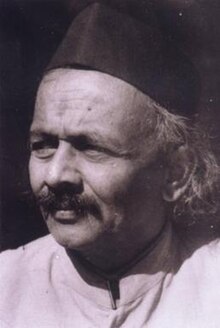
Back دى. آر. بيندرى ARZ দত্তাত্রেয় রামচন্দ্র বেন্দ্রে Bengali/Bangla दत्तात्रय रामचंद्र बेंद्रे GOM दत्तात्रेय रामचंद्र बेन्द्रे Hindi D. R. Bendre ID ದ.ರಾ.ಬೇಂದ್ರೆ Kannada ഡി.ആർ. ബേന്ദ്രെ Malayalam दत्तात्रेय रामचंद्र बेंद्रे Marathi ਡੀ ਆਰ ਬੇਂਦਰੇ Punjabi ڈی آر بیندرے PNB
Dattatreya Ramachandra Bendre | |
|---|---|
 | |
| Born | 31 January 1896 Dharwad, Bombay Presidency, India (now in Karnataka) |
| Died | 26 October 1981 (aged 85) Mumbai, Maharashtra, India |
| Occupation | Poet, teacher |
| Period | 20th century |
| Genre | Poetry |
| Literary movement | Navodaya |
| Notable works | Sakheegeeta, Naadaleele, Kannada Meghadoota,Gangaavatarana, Arulu-Maralu, Naaku Tanti |
Dattātreya Rāmachandra Bēndre (31 January 1896 – 26 October 1981), popularly known as Da Rā Bēndre, is generally considered the greatest Kannada lyric poet of the 20th century[1][2][3] and one of the greatest poets in the history of Kannada literature.[1] A pioneering poet of Kannada's Navōdaya movement and a leading figure in the linguistic renaissance of Kannada in the region of North Karnataka (then part of the Bombay Presidency), Bendre forged a new path in Kannada literature and modern Kannada poetry through his original use of desi Kannada, particularly Dharwad Kannada – the form of Kannada spoken in the North Karnataka region of Dharwad. The richness, originality, and euphony of his poetry, his preternatural feel for the Kannada language, and his charismatic personality would result in him being hailed as a Varakavi (lit. 'boon-gifted poet-seer') by the Kannada people. In a poetic journey that spanned almost 70 years (~ 1914 – 1981), Bendre engaged continuously in what he called Kāvyōdyōga or 'The High Yoga of Poetry'.
A multidisciplinary genius, his library is said to have held books spanning 102 subjects, including Quantum Physics, Mathematics, and Physiology. From very early on, Bendre published his poetry as Ambikātanayadatta (lit. 'Datta, son of Ambika'). Often mistaken for a pseudonym or pen name (in the western sense), Bendre described Ambikatanayadatta as the "universal inner voice" within him that dictated what he, Bendre, then presented in Kannada to the world.[4]
In 1973, Bendre was awarded the Jnanapitha, India's highest literary award, for his 1964 poetry collection, Naaku Tanti (ನಾಕು ತಂತಿ) (lit. 'Four strings').[5] Recognized as Karnataka's Kavikula Tilaka ("Crown-jewel among Kannada Poets") by Udupi's Adamaru Matha, he would also be called a Kāvya Gāruḍiga (~ poet-sorcerer)[6] for his ability to create magical poetry. He was awarded the Padma Shri in 1968[7] and made a fellow of the Sahitya Akademi in 1969.[8]
- ^ a b Amur, G.S (1996). Bhuvanada Bhaagya. Bengaluru: Priyadarshini Prakashana.
- ^ Cite error: The named reference
:1was invoked but never defined (see the help page). - ^ Shivareddy, K.C, ed. (1999). Shatamaanada Kavite 'Jogi'. Karnataka: Kannada Vishvavidyalaya.
- ^ "I (ನಾನು)". darabendreinenglish. 13 April 2016. Retrieved 11 February 2018.
- ^ "Jnanpith | Laureates". Archived from the original on 6 April 2018. Retrieved 31 October 2006.
- ^ "Sorcerer (ಗಾರುಡಿಗ)". Da Ra Bendre in English. Archived from the original on 20 September 2020. Retrieved 28 January 2021.
- ^ "Padma Awards | Interactive Dashboard". www.dashboard-padmaawards.gov.in. Archived from the original on 27 January 2021. Retrieved 28 January 2021.
- ^ "..:: SAHITYA : Fellows and Honorary Fellows ::." sahitya-akademi.gov.in. Archived from the original on 6 February 2018. Retrieved 11 February 2018.
© MMXXIII Rich X Search. We shall prevail. All rights reserved. Rich X Search